Water Bath Canning ; Beginner Friendly Tips and Instruction
This page may contain affiliate links. More Information.
Welcome to the world of home canning. Water bath canning is the perfect place for a beginning canner to start. By the end of this article you’ll have the confidence to pull our your canner and start with some simple projects.
Water bath canning is a method of food preservation where you fill canning jars with your chosen food, submerge them in boiling water for a specific time. The jars will seal during the process. This ensures that your food is safe for storage on the shelf and ready to be enjoyed whenever you desire.
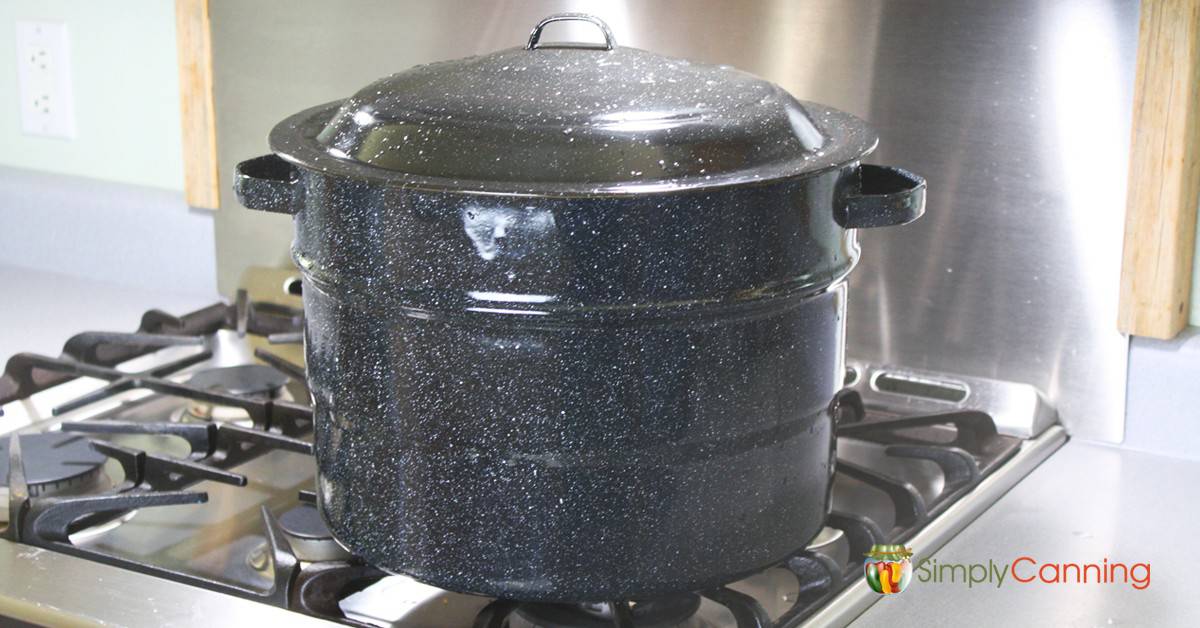
Boiling water canning, hot water bath, are all variations on the same term and mean the same thing as water bath canning.
Water Bath Canning
I’m going to start with how to know what foods can be processed using a water bath. That way you’ll know for sure you are on the right track.
Then I’ve got a full step by step explanation of how to process using a water bath canner from start to finish. I included generous tips and guidance from my experiences. I’ve also got a shorter printable version at the bottom of this post.
I’ll also go into some questions you might have and even answer questions you didn’t know to ask!
We’ve also got all our water bath related recipes and posts here.
Check the Jump To section if you have a particular topic you are looking for.
Water Bath Canning: Extended, Step-By-Step Directions
Gather Your Canning Supplies: (links will take you to a page with more information on that particular supply.)
General kitchen supplies will be needed depending on your recipe; towels and pot holders, pots and bowls, spoons, knives, etc. You’ll also want to be sure you’ve got all ingredients for your canning recipe.
Preparing Canner and Supplies
Depending on your recipe you may want to have your canner heating up while you prep your food to go in the jars. This is usually the best way to work things. The goal is to have your canner and jars hot (not boiling) and ready for the filled jars when you’ve done prepping the food.
Fill your canner about 1/3 -1/2 full of water. Heat water until hot, not boiling.
If processing time is less than 10 minutes, you will need to sterilize your jars. Most water bath canning recipes call for at least 10 minutes of processing time so all you need to do is have warm, clean jars. Rarely do I have to sterilize the jars. But I mention it here just in case you do.
Wash the jars and keep warm. Jars can be washed by hand or in the dishwasher. Make sure your jars are in good condition and do not have cracks or nicks on the rim.
Water Bath Canning – Keep Jars Hot Until Ready to Be Filled
For keeping jars hot, I have three options for you. I listed them in order of my preference. Favorite first!
- Place the jars upside down in the canner that you are already heating up. The steam will warm the jars. This saves space/energy. No extra pot on another burner needed.
- Wash the jars in the dishwasher and then simply leave them there until you’re ready to fill. Keeping the door to the dishwasher closed keeps in the steam and heat. Remove the jars a couple at a time as needed.
- Place the clean jars upside down in a large pot with 2 or 3 inches of hot water. Bring to a boil and turn off heat. Leave the jars in the water until ready to be filled.
Have clean lids on hand. Remember, even in water bath canning, the lids do NOT need to be boiled for sterilization unless you process them for less than 10 minutes. I like to have them in a small bowl of hot water on my counter.
Filling the Jars for Water Bath Canning
Prepare and pack food according to the instructions in your recipe. There are two methods for filling your jars before you put them in the canner.
- Hot pack simply means your food is hot before you put it in the jar. Usually simmer for a few minutes.
- Raw pack is when the food is not cooked as you put it in the jar. This is also sometimes called a cold pack. This does NOT mean you don’t process the filled jars. It just means the food is raw and uncooked as you pack it.
Fill jar, leaving the recommended headspace
Remove air bubbles by running a non-metallic utensil around the inside of the jar. A bubble tool is a special canning tool that helps with this step. (It also helps you measure headspace) I like to use a plastic orange peeler for this step. (When I can’t find my bubble tool!)
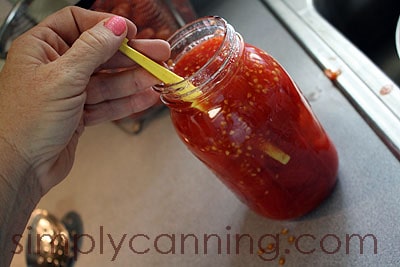
Wipe the rim of the jar clean with a damp tea towel or paper towel.
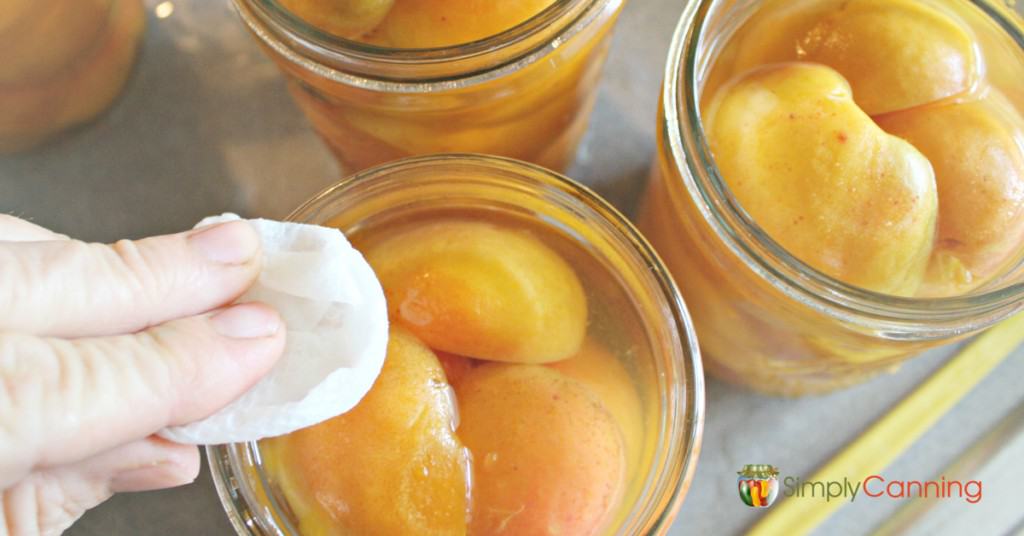
Place seals and rings on jars. I’ve got a video on just what tighten finger tight means. You really don’t have to crank down hard; snug is fine.
Place the filled jars upright on the rack in the canner. The rack will keep your jars off the bottom.
Most water bath canners come with a canning rack. This rack is built so that it rests on the sides of the canner, keeping the jars above the water until you have it loaded and then you can lower it down. The picture below shows the jars lowered into the canner.
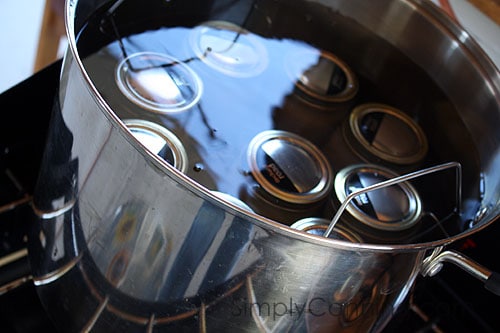
Water needs to flow freely around each jar. Add hot water if needed until the jars are covered by 2 inches of water.
You can also process jars in any pot deep enough to have jars fully covered in boiling water.
You will need to put something under the jars to work as a rack and keep them off the bottom. A neighbor of mine uses a small piece of board. I’ve also heard of using a hand towel.
You’ll also need something to securely hold the jars to place them in the canner. A jar lifter works for this.
Water bath canners and canning tools are not too expensive, so it may be worth it to just get one.
Processing Jars in the Water Bath Canner
So now you have the canner filled with your jars full of food ready to process.
When you are water bath canning, you don’t start your time until the canner comes back to a boil. So put on the canner lid and bring it to a full boil.
NOW start your processing time, being sure to check your recipe to adjust for altitude.
Manage the heat to maintain a rolling boil. The water does need to be actively bubbling and rolling, but it doesn’t need to be so hard it is splashing out of the canner. You may also need to add boiling water to keep the water level up.
When your time is up, turn off the heat. Wait 5 minutes.
Carefully raise the rack and jars up. Wait a couple minutes more before you take your jars out of the canner. This allows the jars to rest a bit and reduce pressure and boiling. The jars may still be boiling. That is normal, but it shouldn’t be boiling so hard that you can see food spurting out of the jar. Read here for more information on liquid loss or siphoning in home canning.
Using a jar lifter, remove the jars and set upright on a wooden board or a thick towel to cool. Be sure they are in a draft-free area and leave 1 to 2 inches of space in between so air can circulate.
Listen…
Did you hear it?? This is my favorite part. As the jars cool, the seals (or flats) will pull down and seal. They make the coolest little pinging sound. For some odd reason, I love that sound. It is so satisfying. It means all my work is working! Water bath canning is so easy!
In case you don’t hear the ping, it’s ok. They don’t always make the sound. It is just cool when they do.
Resist the temptation to press the lids at this point. If your kids are like mine, keep them away too! 🙂 Leave the jars alone until completely cool, allow them to sit undisturbed for a minimum of 12 hours. I usually leave mine out overnight.
Cooling Down, Checking the Seals, & Storage
After jars have cooled, NOW you may press on the lid to check the seal. The seal should be sucked down and not pop up. YOu can also remove the screw band and lift the jar with the edges of the lid. That lid will remain in place if the seal is secure.
If you find a jar that did not seal, simply put the jar in the fridge and plan on using the food within a few days.
Remove the screw band and wash the jar. The outsides will often be sticky. It is a good idea (but not essential) to store without the screw bands.
Label the jar with the food type and date.
You may think that labeling the type of food isn’t necessary if you can obviously see it is canned pears for example. However, what if you are canning applesauce using different types of apples for each batch? You will want to know which is which when you open them later. You can then decide which you like better for next time.
Always record a date, at least the year. That way, when you find a jar way back in your cupboard, you will know how old it is. You think you will keep them straight, but it is so easy to forget and so easy to label them now. Trust me. Just do it.
Store the jars in a cool, dark, dry environment. Usually a pantry is fine. Don’t store in a utility room where there are hot pipes or high humidity. Direct sunlight is a no-no as well.
Stand back and admire the colorful, gleaming jars of nutritious foods ready for your family. Water bath canning is so easy! What? You are tired?! Yes, but it is a satisfying tired, is it not?
Now let’s answer some questions and let me give you some recommendations. If you want a printable checklist on how to use your water bath canner it can be found at the bottom of this post.
What foods are suitable for water bath canning?
Water bath canning is a safe processing method for high acid foods. This would include most fruits, pickled items, jam or jelly, fruit sauce like applesauce.
Tomatoes are a special case. They can be processed in either a pressure canner or a water bath depending on your recipe. Your recipe should specify what method to use. Read more about how to can tomatoes here.
Some foods require pressure canning. Low acid foods like any meat and most vegetables, must be processed in a pressure canner. If you are preserving meat or vegetables, this is not the post for you. You’ll need to learn about pressure canning.
During the water bath canning process several important things happen:
- Heat penetration: As the jars are boiled, heat penetrates through the contents. The heat penetration kills or inactivates spoilers like enzymes, molds, yeast and some bacteria. Processing time of the recipe is important. You need enough time for the heat to penetrate to the center of the jar so that all of the contents will reach a particular temperature.
- Jar sterilization: You do need to start with clean jars but pre-sterilizing your jars and lids is not needed as long as the time of your particular recipe is more than 10 minutes. The boiling water also helps sterilize the jars, killing any remaining microorganisms present on the jar’s surface.
- Expansion and sealing: The heat causes the food and air inside the jars to expand. As the jars cool down after processing, the air contracts, creating a vacuum seal. This vacuum seal prevents the entry of air, bacteria, and other microorganisms that could spoil the food.
Other things to remember or you might be curious about.
Altitude Adjustments.
All good canning recipes should include information on how long to process, and altitude adjustments you need to make. Your processing time is dependent on the altitude or elevation above sea level where you are. This is important because water boils at different temperatures depending on where you live. As you go up in altitude, you’ll add time to your processing. You can find out more on adjusting for altitude here. https://www.simplycanning.com/altitude-adjustments/
Water Bath Alternative Canning Pots
A common question I receive is about the water bath canning pot itself. Do You Have to Have a Special ‘Water Bath Canner’ to Do This? I do recommend getting a specialized canning pot. There are inexpensive options to get you started, and they make it much easier with the handles on the canning rack to pull the jars up out of the water.
The traditional canner you’ll see in many articles is the black speckled canning pot. Like the image at the top of this page. It is inexpensive way to get started.
You might also want to upgrade to a stainless steel canner. I love mine. A benefit is it will be longer lasting and can be used for large batch cooking as well as canning. It also doubles as a steam canner.
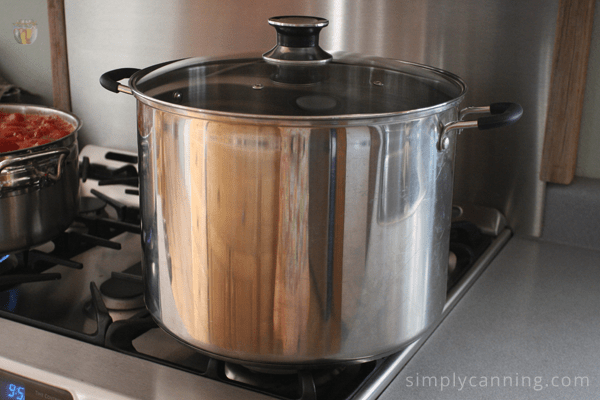
However, the good news is; you can get started with any deep pot.
It must be deep enough to have 2 to 3 inches of water covering the tops of your jars as it boils. It must have some sort of a rack to keep your jars off the bottom of the canner. A deep stock pot with a cake rack in the bottom would work. You could wire together some canning rings to form a rack for an odd size pot if needed.
What About Steam Canning?
Have you heard of steam canning yet? It is a great alternative processing method to replace water bath canning. It uses less water and less time, and I love it. If you haven’t heard of this, check out this page. How to use a steam canner.
Stacking Jars
Did you know you can stack jars in your water bath? The only rule is that you must have all jars covered with 2-3 inches of water at boil. And you need to have a rack between your laters. This is to ensure the jars are stable. I did a video canning chat about stacking jars in a canner.
Jar Breakage
Jars breaking can happen occasionally. The most likely reason would be thermal shock. Putting cold jars into a boiling canner. To avoid this have your canner hot… but not boiling when you add your jars. This evens out the temps bit and you can bring both jars up to a boil at the same time. This does not mean put jars in cold water. The canner does need to be hot to start.
Some other reasons might be. Hairline cracks in the jars already or jars jostling around in the canner during processing. Be sure your jars are in good shape and have a rack to keep your jars secure during processing.
A List of Foods that Can be Processed in a Water Bath Canner
As a reminder, you must have high acid foods to be safe for a water bath.
Frequently Asked Questions
You don’t have to have the lid on the canner but it is a good idea to do so. Keeping the lid on will maintain the heat better. You will need to keep the canner at a rolling boil for the entire processing time. Having the lid will make heating the water to boiling quicker and more fuel efficient. And will control evaporation.
This will depend on the food you are making. Some items are processed for 10 minutes, some can be 30 minutes or more. Larger jars will usually be processed longer that smaller jars. And prep time will vary as well. Jam and jelly may take a while to make, while tomatoes can be a pretty quick prep time.
Yes, the jars should be fully submerged. When you are pressure canning or steam canning the jars are not submerged.
Any low acid food, which means any meat or vegetable, or recipe that includes meat or vegetables. Pickled items are usually ok with a water bath. For example – tested salsa recipes have that added acid so even though they have vegetables they can be water bath canned.
Printable Checklist
Water Bath Canning
Equipment
Materials
- High-acid Food fruit, jam or jelly, pickled items; any high-acid food that you want to process
Instructions
- Fill your canner about half full of water. Start heating it up. The goal is for the canner to be hot but not boiling as you are filling your jars. You want enough water to cover your jars when they are filled and in the canner. Have a teapot of hot water available in case you need to top it off.
- Wash and rinse your jars and lids. (They do not need to be sterilized.) Keep your jars hot until use. The best way is to place them in the canner rack raised above the water while it heats up.
- Prepare and fill jars according to the canning directions for that food. Remember proper headspace, removing bubbles if needed, wipe down the rims of your jars, and put on the lids and rings.
- Place the filled jars in the canner. Continue until all jars are filled.
- Lower the jars into the water; if needed, add hot water so the jars are covered by about 2 inches. Put your lid on the canner and raise your heat and bring to a boil.
- When your water is at a rolling boil, start your processing time at that point. The proper processing time for your altitude will be given in your recipe. Different altitudes will have different times. The higher you live, the longer you process. Make sure the water remains above the level of the jars. Add hot water as needed.
- When the processing time is completed, turn off the heat. Open the lid to allow steam to escape. (Carefully, don't let it hit your face or arms!) Wait 5 minutes. Raise the rack and jars above the water. Allow them to rest another 5 minutes. Now remove your jars. (Optionally, you can wait another 5 minutes if the contents appear to be bubbling so hard it is coming out of the jars.)
- Put the jars on a counter with a thick towel beneath them to protect the hot jar from the cool counter. Allow them to cool to room temperature undisturbed. 12 hours is suggested. Do not try to speed up the cooling process.
- When they are cool, remove the metal bands, check the seals, and store the jars in a cool, dark place.
Pin This to Find Later!
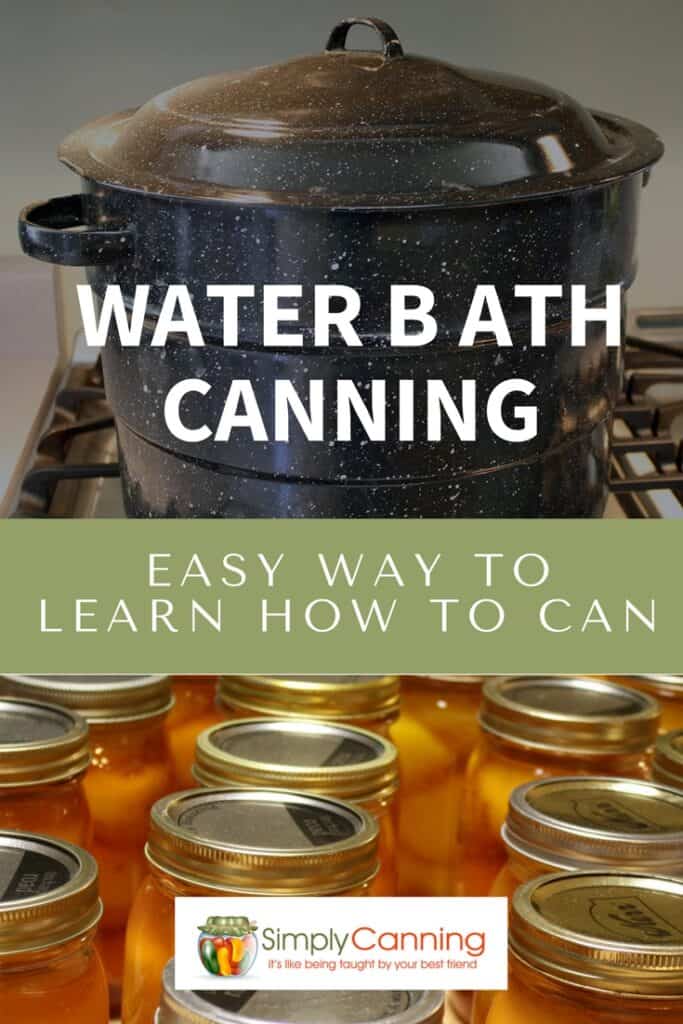


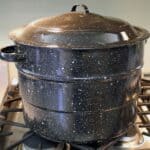
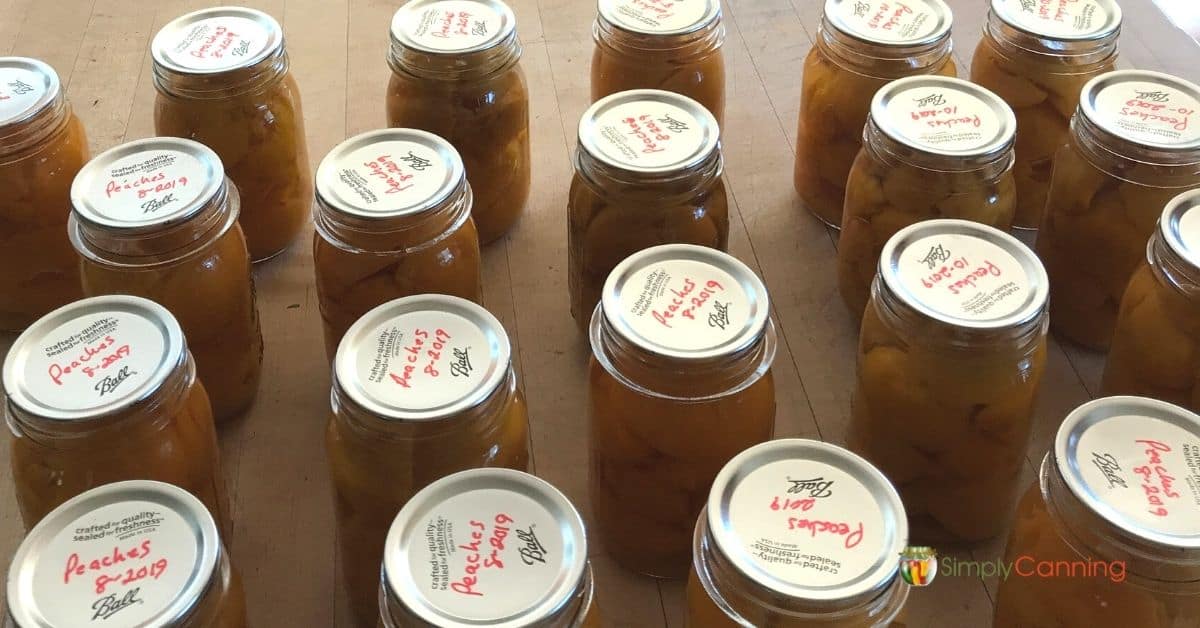
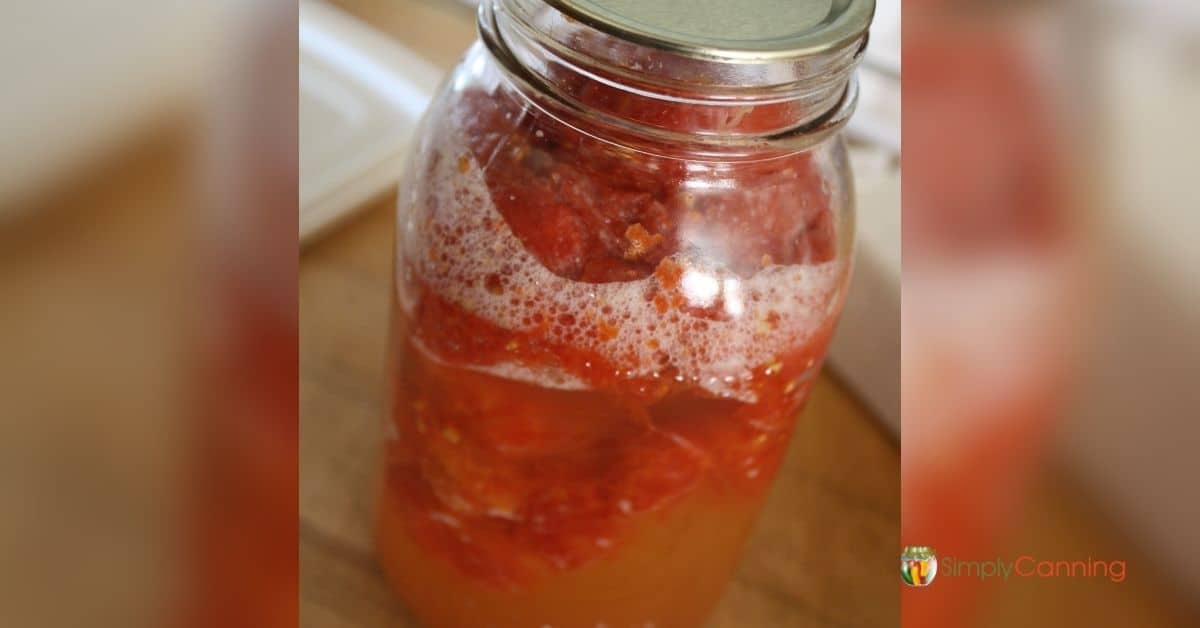
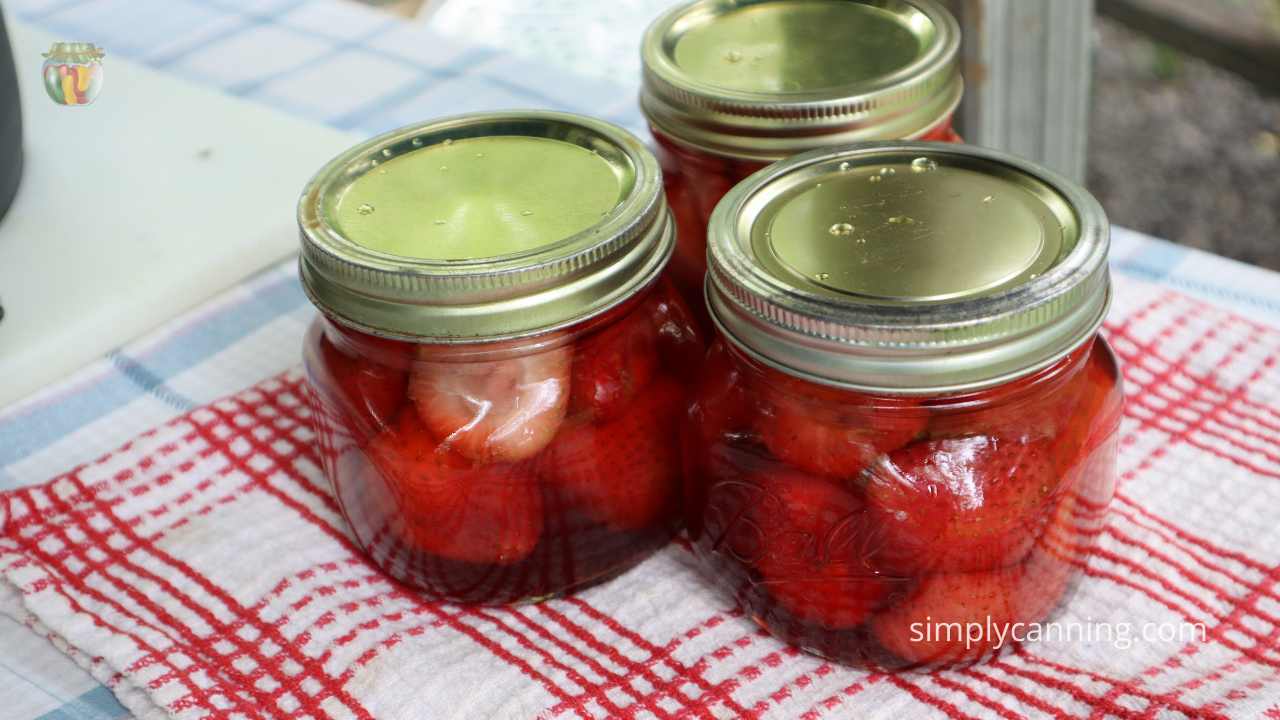
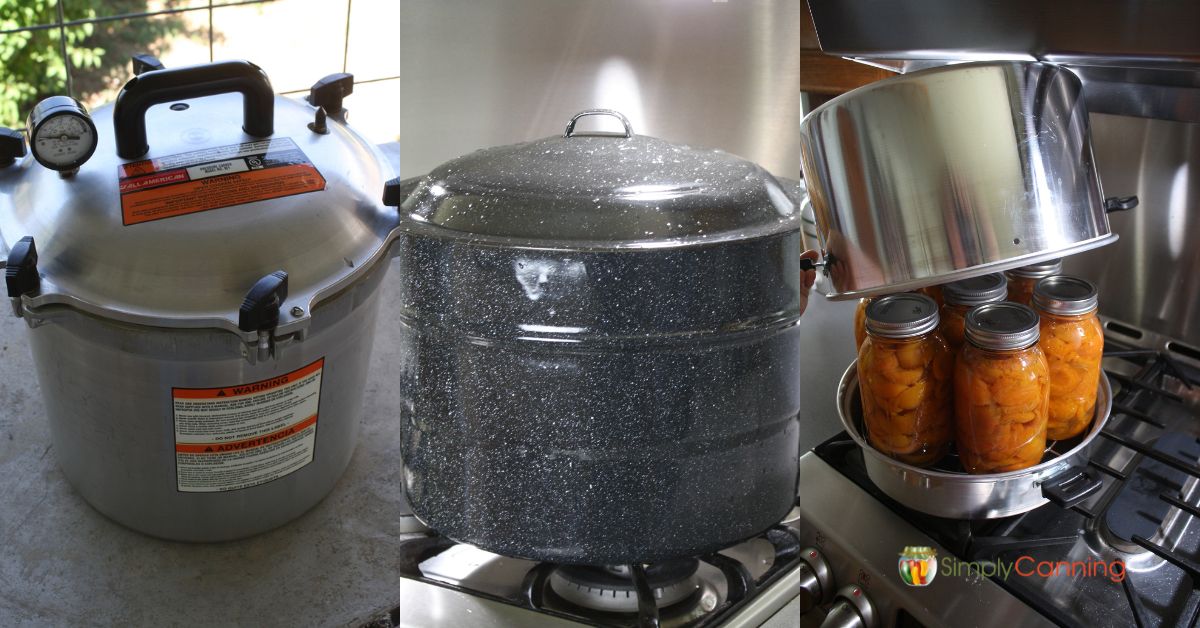
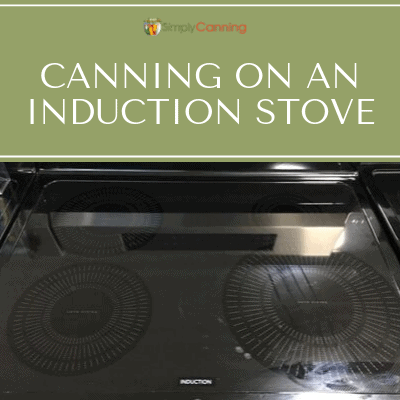
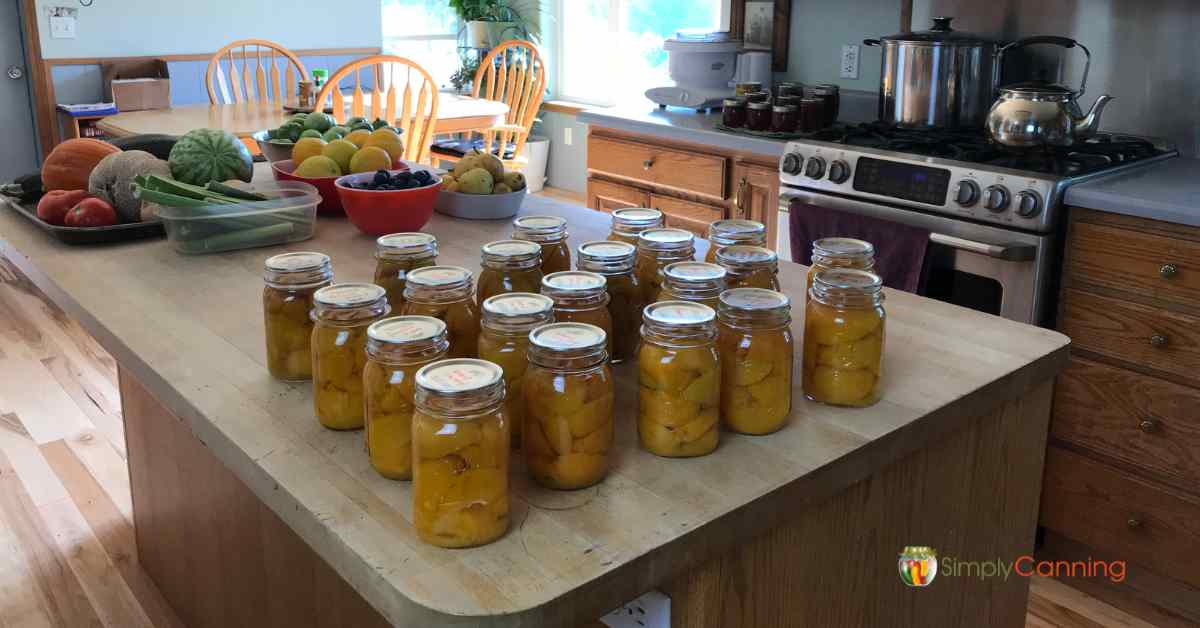
why do you take the bands off the jars?
The bands tend to rust if you leave them on the jars. And potentially could hide a failed seal. If a seal fails in storage I want to know that it has failed. I don’t want the band to hold the lid on, I want the seal to hold the lid on. Great Question!
This story will start as many canning stories start…My Mom… My Mom had seven children. This wasn’t way back when, way out on the farm. This was in the suburbs (although most didn’t call them that then) in the 60’s and 70’s (7 kids takes awhile) when families of that size were rarer. My Dad was an only child and wanted a large family. He bought a tiny house on 3 lots and proceeded to add on and built us a home to fit. 5 bedrooms library, huge rec-room storage room and a living room that was 18′ X 53′.… Read more »
Thanks for your story Dan. and thanks for pointing out the typo! I’ve got it all fixed now.
Loved the part about waiting for the ‘ping’ when the jars are sealing after processing them. I always had the same reaction that you described. Thank you for the great memory.
Mary in Nevada
I canned spaghetti sauce without meat in a hot water bath; however, I forgot to add 2 tablespoons of lemon juice. Will they be safe? The jars sealed.
Marlene, I don’t believe your recipe is safe as you canned it. My guess is it is NOT safe. I’m assuming you added onions or peppers to your sauce in which case it is likely you actually needed to use a pressure canner to process it. Here is a safe way to can spaghetti sauce without meat.
Hi.
Can I water-bath can with the bottle sideways?
Joe
Joe, no the jars must be in the upright position. So if you are water bath canning your pot must be deep enough for the jar to sit upright and still be covered in water.
How many minutes to can by water bath for peaches in quarts?
Follow the processing time for your altitude on this page. 🙂 https://www.simplycanning.com/canning-peaches/
-Rachel (Sharon’s assistant)
Do I have to first blanch yellow cherry tomatoes before water bath canning? Prefer not to unless I have to for safety. I thoroughly washed the tomatoes first, sterilized jars, lids, put tomatoes in jars with 1/4 tsp citric acid, debubbled jar, allowed for headspace, covered tomatoes with boiling water in jar allowing for headspace, then processed jar in boiling water for 40 min. Is that OK?
Yes, you should blanch and peel your tomatoes. It is a bummer because they are so easy but the good news is… they peel really easy! Fast blanch as they are so small and just pinch one end and the skins pop right off. Now having said that, this is somewhat of a debate in the canning world. Some people do leave on skins or just blend tomatoes up to make a sauce. But just know that all tested methods indicate peeling those tomatoes. Even if you wash them, the bacterial load of washed tomatoes will be more than peeled… Read more »
Hi Sharon, Going to start my first project tomorrow making blackberry jam! I don’t have a water bath canner! Have a pot – Paula dean porcelain with non stick. Smooth bottom. Can I use this? Also I don’t have a jar lifting rack. Do I need one? I have a rack to keep jars off the bottom-just doesn’t have handles and jar lifting rings. Do you recommend I get one for my new presto 23 quart pressure canner I ordered this morning?
Love your site! I’m taking the 7 day free course! Day 2!
Thank you!
Laura B
Hi Laura, For waterbath canning all you need is a pot deep enough that your jars can be covered with a couple inches of water while bioling and you have a rack under your jars. the handles are handy but not required. YOu can pull your jars out one by one with a jar lifter. I do recommend a jar lifter OR the canning rack. The jars will be super hot and a pot holder or towel is difficult to handle them. I talk more about canning racks here. As far as the pressure canner it should come with a… Read more »